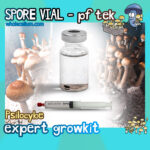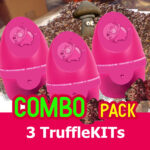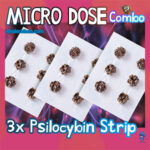The pursuit of wellness has opened up. Integrating traditional and modern therapeutic methods has become the practice du jour. In realizing that there is never just one way to do things — especially when it comes to the human body and mind — we open up ways of healing that can work for every individual.
Magic mushrooms and acupuncture may seem unlikely bedfellows at first — however they are both popular methods of holistic healing — each with a lineage of traditional usage (for example, the Indigenous people of Central America, and Traditional Chinese Medicine respectively.) In this article we will explore how and why there is a growing interest in combining the two, and what benefits this may offer.
What is Acupuncture?
You may be familiar with, or even had acupuncture yourself. Or maybe you’ve just seen a hilarious sitcom episode where someone freaks out at the thought of a bunch of needles in their face. Whatever, your ‘in’, it’s important to know that acupuncture is a key component of Traditional Chinese Medicine (TCM), with a history spanning over 2,500 years. It was first practiced in ancient China, and has been used across Asia for millenia. The first recorded mention of acupuncture is found in the Huangdi Neijing (The Yellow Emperor’s Classic of Internal Medicine), dating back to around 100 BCE.

How Does Acupuncture Work?
According to Traditional Chinese Medicine, the body contains a vital life energy known as ‘Qi’ (pronounced ‘chee”) that flows through pathways in our body called ‘meridians’. When Qi flows freely, we are healthy. However, blockages or imbalances of Qi flow lead to illness. Acupuncture is the practice of inserting very, very thin needles into specific points along our meridian lines, to restore balance, unblock, and promote healing.
While the concept of Qi is central to Traditional Chinese Medicine, modern scientific research has proposed several theories as to how acupuncture exerts healing effects.
- Neurological Effects: Acupuncture stimulates nerves, leading to the release of endorphins and other neurotransmitters that reduce pain and promote a sense of well-being.
- Improved Blood Flow: Needling can increase local blood circulation, enhancing tissue repair and reducing inflammation.
- Regulation of the Autonomic Nervous System: Acupuncture may balance the sympathetic and parasympathetic nervous systems, reducing stress and helping us to relax.
- Modulation of Immune Function: Some studies suggest that acupuncture can influence immune system activity, potentially improving overall health.
The Healing Powers of Magic Mushrooms
As you likely know if you found yourself reading this article, magic mushrooms are a naturally occurring psychedelic that has been found to have healing properties, on top of their characteristic ‘trip’. Psilocybin, (the name of the psychoactive compound found in shrooms) is known for its profound effects on perception, mood, and cognition, making it a promising candidate for therapeutic use in various mental health conditions.

The Therapeutic Benefits of Psilocybin
Research has shown that psilocybin can be effective in treating conditions such as depression, anxiety, PTSD, and addiction. The therapeutic benefits are often attributed to psilocybin’s ability to:
Enhance Neuroplasticity: Psilocybin promotes the growth and reorganization of neural connections.
Facilitate Emotional Release: Users often experience profound emotional insights and a release of repressed emotions.
Induce Mystical Experiences: These experiences can lead to a sense of interconnectedness and profound personal meaning.
How Magic Mushroom Therapy Works
In a therapeutic setting, psilocybin is administered in a controlled environment with the guidance of trained professionals. The therapy typically involves preparation sessions, the psilocybin experience itself, and integration sessions to process and incorporate insights gained during the experience.
Synergistic Benefits of Combining Magic Mushroom Therapy and Acupuncture
Synergy is when two things come together, and work together, to create a greater effect. Combining magic mushroom therapy with acupuncture could potentially amplify the benefits of both treatments through their complementary mechanisms. Here’s how this could work:
Enhanced Emotional Processing: Psilocybin can bring repressed emotions to the surface, while acupuncture can help manage the emotional and physical responses, promoting a sense of calm and balance.
Neuroplasticity and Healing: Psilocybin-induced neuroplasticity may be supported by acupuncture’s ability to regulate the nervous system and improve blood flow, potentially accelerating psychological and physical healing.
Stress Reduction: Both therapies are known to reduce stress and anxiety. Together, they may provide a more comprehensive approach to managing stress-related conditions.

How Could Combining These Therapies Look In Practice?
In practice, combining these therapies would involve a coordinated approach:
Preparation: Prior to the psilocybin session, acupuncture could be used to promote relaxation and prepare the body and mind for the experience.
Psilocybin Session: During the session, acupuncture could be used to help manage acute physical and emotional responses, ensuring a smoother experience.
Integration: Following the psilocybin session, acupuncture can aid in the integration of insights and emotional processing, helping to ground the individual and support ongoing healing.

Alternately, combining a psilocybin microdosing practice with regular acupuncture sessions is another way to integrate this healing possibility into your lifestyle more independently.
Case Studies and Anecdotal Evidence
While research on the combined use of psilocybin and acupuncture is limited, anecdotal reports suggest promising outcomes. Individuals who have undergone both treatments often report enhanced emotional clarity, reduced symptoms of anxiety and depression, and a greater sense of overall well-being.
Combining Psilocybin and Acupuncture: Conclusion
The integration of magic mushroom therapy and acupuncture offers an exciting convergence of ancient and modern (depending on who you ask!) healing practices. By harnessing the unique benefits of each method, practitioners can offer a comprehensive approach to wellness that addresses both the mind and body. As research in this area continues to evolve, we may uncover even greater potential for these therapies to transform mental health care and holistic wellness practices.





